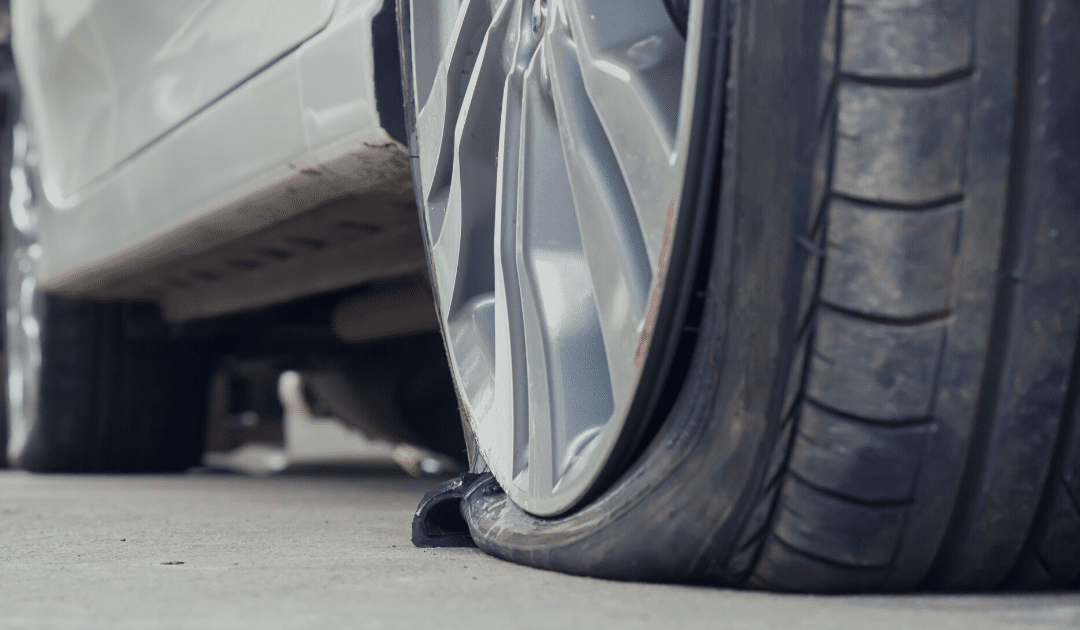A tire blowout is a rapid loss of air that causes your vehicle to lose control. It’s a dangerous surprise that can happen anytime your car is in motion. If you are driving down the road and suddenly hear a loud POP or THUD and feel your car begin to jerk or pull to the side, odds are you have just experienced a blowout.
Tire blowouts can be frightening, especially for young or inexperienced drivers, and can cause you to feel like you’re losing control of your vehicle. Blowouts cause 78,000 crashes a year, so keeping your cool and knowing how to proceed after a blowout is vital.
Here’s what to do if a blowout happens to you.
Step 1: Don’t panic. The most important thing you can do during a blowout is to stay calm. Don’t try to immediately overcorrect or press on your brakes- this could cause you to lose even more control.
Step 2: Grip the steering wheel firmly. Keep both hands on the steering wheel and keep the car moving forward in a straight line. You may feel the need to try and steer off to the side of the road or overcorrect if it starts to fishtail- don’t. To avoid an accident keep the car as straight as you can.
Step 3: Tap your gas pedal. If you are trying to regain control of your vehicle, accelerating lightly will help you because you are keeping your forward momentum. Braking immediately will only cause the car to become harder to control and could lead to an accident. Gently press the gas pedal and adjust to how the car moves. Once you’ve regained full control, slowly remove your foot from the accelerator and let the car slow.
Step 4: Brake Slowly. When your speedometer reads 30mph, it’s safe to slowly begin braking. After you have slowed enough to begin hitting your breaks it is safe to steer the vehicle into the rightmost lane or shoulder of the road (if possible). Continue braking steadily until your car stops completely.
Step 5: Put on your hazards. Put it in park and turn on hazard lights or put out reflective triangles and collect yourself. If you are still in the middle of the road, you should exit your vehicle and get to safety- out of the way of a collision.
Step 6: Change your tire or call roadside assistance. If you can safely change your tire and there is no damage done to your rim, now is the time to do so. If you cannot safely change your tire or don’t have a spare call for roadside assistance.
How to Avoid a Future Blowout.
A tire blowout may happen due to a number of circumstances: underinflation, too much weight in the vehicle, hitting a pothole or other debris, and even over-wear.
To avoid a future blowout, try to miss potholes & debris- when you can safely do so- and make sure to maintain your tires. You can do this by routinely checking your tire pressure, monitoring your tires for wear and tear (even small cuts and other minor defects can lead to a blowout), and most importantly keeping up with getting new tires.
New tires can generally last you anywhere from 25,000 to 50,000 miles. You will want to refer to your owner’s manual for recommendations on what tires you can put on your vehicle and their lifespan. A great way to keep your tires in check is to monitor their tread. You can do this by using the quarter test. If you are unfamiliar with the quarter test, here’s how it works- place a quarter in the center of the tread (thickest part of the tire), with the head facing you, in a new tire the quarter will easily fit and you should be unable to see the hair on the top of the head. If the hair is partially visible, you should think about replacing the tires. If you can see the very top of the head, the tires need to be replaced right away.
What About Insurance?
So, are you covered if you experience a tire blowout? Your auto insurance policy may cover sudden or accidental damage to your tires, like a blowout, depending on your policy.
Before an unexpected blowout happens to you make sure you’re covered. Check with your auto insurance provider or call in to review your policy.
This article is furnished by California Casualty, providing auto and home insurance to educators, law enforcement officers, firefighters, and nurses. Get a quote at 1.866.704.8614 or www.calcas.com.
- Graduation – When to Remove Your Child from Your Auto Policy - May 18, 2023
- How to Prevent Catalytic Converter Theft - May 17, 2023
- How Much Does Home Insurance Cost? - May 17, 2023

